Refinery
Hazard to Others
  
Posts: 371
Registered: 17-2-2014
Member Is Offline
Mood: Still
|
|
Single displacement reaction for lead?
I was gonna make some lead acetate by single displacement reaction with copper acetate.
However, it looks like to me that on Youtube videos, the base metal does not corrode at all, but only the dissolved metal precipitates out. How is
this possible, if the base metal is supposed to replace each ion pair?
|
|
|
DraconicAcid
International Hazard
    
Posts: 4333
Registered: 1-2-2013
Location: The tiniest college campus ever....
Member Is Offline
Mood: Semi-victorious.
|
|
It may look like that, but the copper does go into solution.
Please remember: "Filtrate" is not a verb.
Write up your lab reports the way your instructor wants them, not the way your ex-instructor wants them.
|
|
|
unionised
International Hazard
    
Posts: 5126
Registered: 1-11-2003
Location: UK
Member Is Offline
Mood: No Mood
|
|
I presume you mean lead.
|
|
|
DraconicAcid
International Hazard
    
Posts: 4333
Registered: 1-2-2013
Location: The tiniest college campus ever....
Member Is Offline
Mood: Semi-victorious.
|
|
Yes, of course.
Please remember: "Filtrate" is not a verb.
Write up your lab reports the way your instructor wants them, not the way your ex-instructor wants them.
|
|
|
Refinery
Hazard to Others
  
Posts: 371
Registered: 17-2-2014
Member Is Offline
Mood: Still
|
|
By any reason it should do so.
I melt the lead and poured it through a sieve into water to maximize its surface area. I store it underwater to keep it from oxidizing until I get my
reagents.
Ca Acetate + CuSO4 = CaSO4 + Cu Acetate
Cu Acetate + Pb = Pb Acetate + Cu
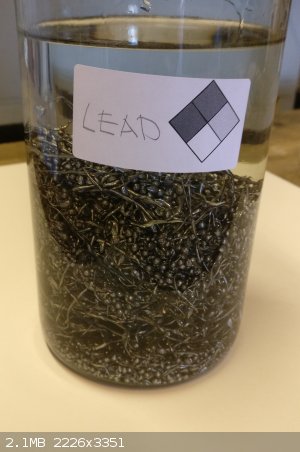
|
|
|
Refinery
Hazard to Others
  
Posts: 371
Registered: 17-2-2014
Member Is Offline
Mood: Still
|
|
Is there a viable method to separate Cu acetate and Pb acetate? Former appears to have much lower solubility, hence it could possibly be concentrated
and then cooled down to crash out Cu?
|
|
|
UC235
National Hazard
   
Posts: 565
Registered: 28-12-2014
Member Is Offline
Mood: No Mood
|
|
Quote: Originally posted by Refinery  | | Is there a viable method to separate Cu acetate and Pb acetate? Former appears to have much lower solubility, hence it could possibly be concentrated
and then cooled down to crash out Cu? |
Just use an excess of lead and let it sit until the solution is no longer blue.
|
|
|
Refinery
Hazard to Others
  
Posts: 371
Registered: 17-2-2014
Member Is Offline
Mood: Still
|
|
I presume this takes quite a long time?
|
|
|
artemov
Hazard to Others
  
Posts: 181
Registered: 22-8-2018
Member Is Offline
|
|
Sorry for resurrecting this thread. I am doing this now ... trying to get lead acetate for the golden rain experiment.
So basically I have 0.01 mol (about 2.2g) of basic copper carbonate and 100 ml of vinegar. Very slow to react.
About 8.7 g of lead shots are added (double the stoichiometric amount) ...
After 30 hours, all the greenish basic copper carbonate are gone, lead shots are coated with shiny copper, lotsa blackish ppt (coarse and fine), but
the solution is still quite bluish green ...
I am not sure how pure are my lead shots, should I add more?
How long do I need to wait for the solution to clear up? Cheers.
|
|
|
B(a)P
International Hazard
    
Posts: 1139
Registered: 29-9-2019
Member Is Offline
Mood: Festive
|
|
Quote: Originally posted by artemov  | Sorry for resurrecting this thread. I am doing this now ... trying to get lead acetate for the golden rain experiment.
So basically I have 0.01 mol (about 2.2g) of basic copper carbonate and 100 ml of vinegar. Very slow to react.
About 8.7 g of lead shots are added (double the stoichiometric amount) ...
After 30 hours, all the greenish basic copper carbonate are gone, lead shots are coated with shiny copper, lotsa blackish ppt (coarse and fine), but
the solution is still quite bluish green ...
I am not sure how pure are my lead shots, should I add more?
How long do I need to wait for the solution to clear up? Cheers. |
If you have peroxide you can go straight to lead acetate from acetic acid and metallic lead. If you have lead oxide you can do it without the
peroxide. You may already know this, but I thought I would include this incase one of them is an easier route for you.
|
|
|
Fyndium
International Hazard
    
Posts: 1192
Registered: 12-7-2020
Location: Not in USA
Member Is Offline
|
|
In my experience the displacement reaction produced low yield. The lead acetate was recrystallized multiple times to result pure white crystals, but
losses were significant.
If you need lead acetate other than fun of making it, get lead oxide or use hydrogen peroxide method.
I'm not sure if one can do the reaction with sodium percarbonate and acetic acid.
|
|
|
artemov
Hazard to Others
  
Posts: 181
Registered: 22-8-2018
Member Is Offline
|
|
Thanks guys, if this one doesn't work out well I'll probably try that.
Refinery you have any update?
|
|
|
artemov
Hazard to Others
  
Posts: 181
Registered: 22-8-2018
Member Is Offline
|
|
Ok the solution has cleared up. Took 4 days or so with excess vinegar (2x) and lead (3x). Perhaps with more patience, stirring and hot water baths,
less excess reactants will be needed.
Pic 1: Freshly prepared basic copper carbonate + vinegar
Pic 2: After 1 day with lotsa undissolved basic copper carbonate, before lead shots are added
Pic 3: 3 days after lead shots are added
Pic 4: 4 days after lead shots are added
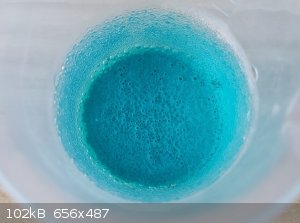 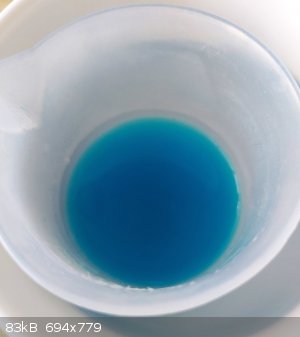 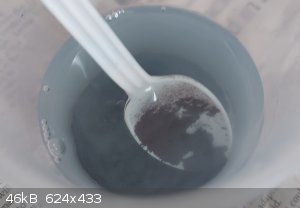 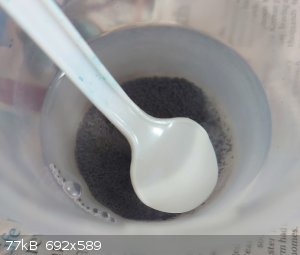
|
|
|
MidLifeChemist
Hazard to Others
  
Posts: 192
Registered: 4-7-2019
Location: West Coast USA
Member Is Offline
Mood: precipitatory
|
|
Artemov - so it looks like after 4 days, all the CuCO3 dissolved and all the Cu in solution was displaced by Pb, so now you have only Lead acetate in
solution - is that correct?
|
|
|
artemov
Hazard to Others
  
Posts: 181
Registered: 22-8-2018
Member Is Offline
|
|
Quote: Originally posted by MidLifeChemist  | | Artemov - so it looks like after 4 days, all the CuCO3 dissolved and all the Cu in solution was displaced by Pb, so now you have only Lead acetate in
solution - is that correct? |
Yup should be .... I have filtered the solution and is now trying to crystallize out the lead acetate via slow evaporation. Will update after a couple
of weeks 
[Edited on 30-10-2020 by artemov]
|
|
|
MidLifeChemist
Hazard to Others
  
Posts: 192
Registered: 4-7-2019
Location: West Coast USA
Member Is Offline
Mood: precipitatory
|
|
Why so slow? Are you trying to get crystals with a certain look or quality? Or that the only way you can get the product without decomposing it?
|
|
|
artemov
Hazard to Others
  
Posts: 181
Registered: 22-8-2018
Member Is Offline
|
|
Quote: Originally posted by MidLifeChemist  | | Why so slow? Are you trying to get crystals with a certain look or quality? Or that the only way you can get the product without decomposing it?
|
I dun really want to heat it as it's a toxic salt ... and I prefer bigger crystals, for safety sake too ...
Not too sure about that ... but I added excess vinegar to prevent hydrolysis, so I heard.
|
|
|
XeonTheMGPony
International Hazard
    
Posts: 1640
Registered: 5-1-2016
Member Is Offline
Mood: No Mood
|
|
Crosman Lead pellets .22 cal I found to be pretty pure Lead.
I added these to concentrated vinegar and 30% peroxide solution then heated and stirred, I kept adding lead to no more dissolved.
Allowed to cool, then filtered off mystery white powder (Guessing antimony oxide)
Boiled down and evaporated to dryness.
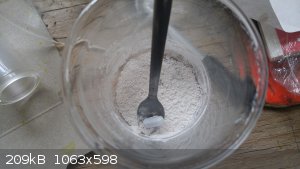
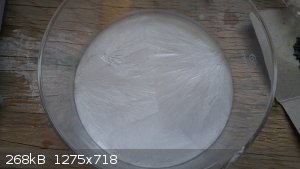
|
|
|